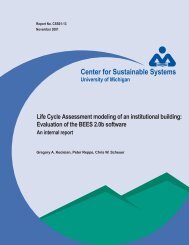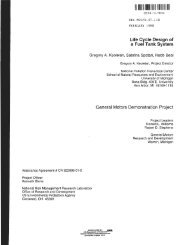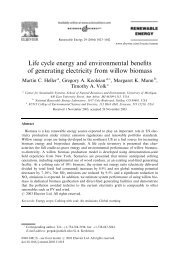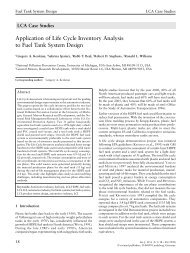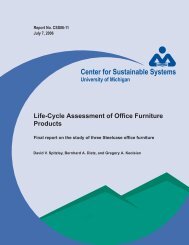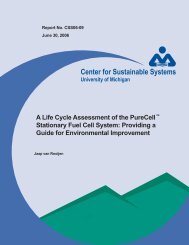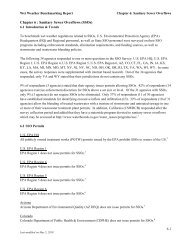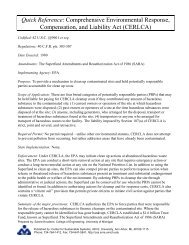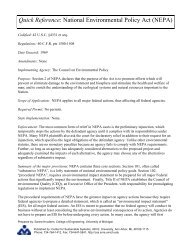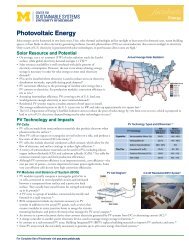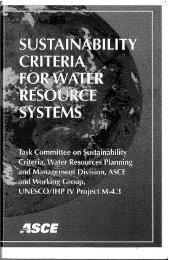Life Cycle Optimization of Residential Air Conditioner Replacement
Life Cycle Optimization of Residential Air Conditioner Replacement
Life Cycle Optimization of Residential Air Conditioner Replacement
Create successful ePaper yourself
Turn your PDF publications into a flip-book with our unique Google optimized e-Paper software.
5.3 Comparing Optimal <strong>Replacement</strong> to Typical <strong>Replacement</strong> PatternsIt is useful to compare the optimal results obtained in Section 5.3 to those for a typicalreplacement pattern. It is difficult to know the typical age at replacement. Industry <strong>of</strong>ficialscontend that the average age <strong>of</strong> replacement is anywhere between 11 to 15 years (DOE, 2008).A typical lifetime <strong>of</strong> 13.67 years was chosen because it allows for three units to be purchasedand used between 1985 and the end <strong>of</strong> 2025. If another length <strong>of</strong> time was selected, the resultsmay have been subject to distortion since at least one unit would have to be disposed <strong>of</strong>prematurely. For instance, if a 12 year lifetime was selected replacements would occur in 1997,2009, and 2021. However, the 2021 unit would only be in use for 5 years before retiring it againat the end <strong>of</strong> 2025 and the full benefits <strong>of</strong> the operational savings <strong>of</strong> energy, GHG emissions, andcost would not be realized.Since the model only allowed for replacement at the start <strong>of</strong> each year, three scenarios werecreated where the CAC was replaced after every 14 years with one interval <strong>of</strong> 13 years thatrotated between the first, second, and third period in the respective scenarios. The impactsgenerated from these three replacement schedules were very similar and thus they wereaveraged together to represent a single typical replacement scenario.The optimal results were then compared to the impacts that were associated with a typicalreplacement pattern starting in 1985. These results are shown for Ann Arbor and San Antonio inTable 5.3 and Table 5.4. Results for other locations are given in the Appendix.Table 5.3: Comparison <strong>of</strong> Optimal <strong>Replacement</strong>s to Typical <strong>Replacement</strong> Scenario UsingProcess LCI Data<strong>Life</strong> <strong>Cycle</strong> Impacts <strong>of</strong> Typical<strong>Replacement</strong>Savings from Optimal vs. Typical<strong>Replacement</strong>Energy GHG (kg Cost Energy GHG CostCity Objective (MJ) CO2 eq.) (2009$)Ann Arbor Energy 1,115,000 90,400 22,200 4.7 % 0.1 % (19.3 %)GHG 1,115,000 90,400 22,200 3.1 % 2.4 % 0.8 %Cost 1,115,000 90,400 22,200 2.8 % 1.4 % 2.4 %San Energy 3,818,000 222,400 46,700 6.1 % 1.8 % (24.2 %)Antonio GHG 3,818,000 222,400 46,700 4.9 % 3.7 % (2.9 %)Cost 3,818,000 222,400 46,700 2.8 % 2.3 % 2.5 %Table 5.4: Comparison <strong>of</strong> Optimal <strong>Replacement</strong>s to Typical <strong>Replacement</strong> Scenario UsingEIO‐LCA Results<strong>Life</strong> <strong>Cycle</strong> Impacts <strong>of</strong> Typical<strong>Replacement</strong>Savings from Optimal vs. Typical<strong>Replacement</strong>Energy GHG (kg Cost Energy GHG CostCity Objective (MJ) CO2 eq.) (2009$)Ann Arbor Energy 1,101,000 90,000 22,200 5.4 % (2.9 %) (44.3 %)GHG 1,101,000 90,000 22,200 3.1 % 2.4 % 0.8 %Cost 1,101,000 90,000 22,200 2.7 % 1.3 % 2.4 %San Energy 3,803,000 222,000 46,700 6.7 % (1.0 %) (48.3 %)Antonio GHG 3,803,000 222,000 46,700 5.0 % 3.8 % (2.9 %)Cost 3,803,000 222,000 46,700 2.8 % 2.2 % 2.5 %a) EIO‐LCA results refer to modeling <strong>of</strong> the unit production. See Section 3.1 for details.



